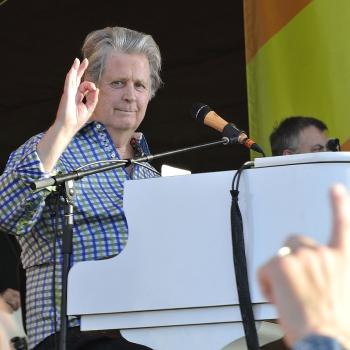The Adventurous Lectionary – The First Sunday in Lent – February 22, 2015
Bruce Epperly
Genesis 9:8-17
Psalm 25:1-10
I Peter 3:18-23
Mark 1:9-15
Today’s readings can take a preacher and congregation in a variety of directions. We can reflect on mystical experiences, the Holy Spirit, the nature of temptation, God’s care for the non-human world, and the scope of salvation. Perhaps, these apparently disparate topics are joined together by Jesus’ calling to share God’s good news. God’s good news is reflected in the rainbow, spiritual insights, the struggle for self-awareness, and second chances given to us even beyond the grave.
Mark is the master of brevity. Within a few short verses, we read of Jesus’ baptism, the descent of the Spirit, the retreat (or temptations) in the wilderness, and the startup of Jesus’ ministry. Such literary conciseness opens up the imagination of preacher and congregation alike. The imaginative reader is filled with questions about this brief reading in which four apparently separate events flow into one another in an organic way.
John baptizes Jesus, and that’s enough said, at least from Mark’s perspective. Yet, we wonder why Jesus needed to be baptized if he was God’s chosen messenger and savior. Of course, Mark doesn’t yet tell us of Jesus’ uniqueness and suggests that in some way the Holy Spirit touches Jesus, empowering him and singling him out, in the wake of his baptism. What does it mean for the Spirit to descend upon Jesus? Is this somehow physical, like the flight of dove? Or is Jesus filled with superabundance of divine energy, insight, and wisdom? Is Jesus’ self somehow transformed in such a way that power flows from him to change peoples’ lives, body, mind, spirit, and relationships? Is this the moment when Jesus fully discerns his vocation as God’s beloved son and healer of humankind?
Mark suggests that concurrent with John’s baptism, Jesus has a mystical experience in which the heavens are opened and Jesus receives a vision of God’s inner life and vision for human life.
Mysticism alone cannot guide our vocational path. Jesus needs to ground his mystical encounters in prayer, meditation, and fasting. The same Spirit that enlivens also compels, and so Jesus is driven into the wilderness, where he is tempted by Satan. Our greatest gifts and aspirations can become harmful if they are not channeled through God’s wisdom and our own spiritual maturity. Dramatic as it was, spiritual insight and paranormal experience is not enough. Mark doesn’t tell us the ways Jesus was tempted, and perhaps that’s good news. His brevity and silence enables us to explore our own temptations, and the good things we dwell upon that keep us from what is best for us and others.
Surely we live in wonderful time, in which many of us the world’s knowledge at our fingertips and can communicate on social media and the internet in the blink of an eye. But, are our lives necessarily healthier or happier? And, given the nature of much Facebook communication or media analysis, it appears that we often succumb to the lowest levels of humankind – polarization, divisiveness, dishonesty, exclusion – rather than aim toward our highest selves. We have to ask ourselves, “How can we use our technology to heal rather than hurt, to unite rather than divide?”
Jesus goes to be alone, but finds himself in a crowd. Wild beasts abound and so do angels. It is unclear whether these wild beasts are menacing or friendly. Could it be that the covenant with all creation, described in Genesis 9, is fulfilled as Jesus – like St. Francis – reaches out to Brother Wolf and Sister Snake? In any event, Jesus time of testing and temptation is not entirely solitary. Angels “wait” on Jesus. Spiritual powers support his journey. Could we be supported, unknown to us for the most part, by spiritual presences whose purpose is to guide us from falsehood to truth and self-interest to compassion? Are we in the presence of our “better angels,” to quote Lincoln, who call us to follow what is best in ourselves and humankind?
Jesus’ retreat in the wilderness ends, and he is lured from silence of the wilderness to the cacophony of human need. Contemplation is balanced by action. Introspection gives birth to outreach. Jesus has to go public. So begins the public message of God’s good news to humankind. Once more, the imaginative pastor and congregant is invited to consider, “What is God’s good news? What’s the good news we share with others here in church? In what ways can we good news givers?”
Mark doesn’t give us an outline of Jesus’ message, but surely his good news involves the invitation to personal transformation, to see ourselves and others in new ways, to discern our relationship with God’s realm, and open to God’s healing and welcoming touch.
While ambiguities are present in the passages from Genesis and Peter, taken apart from context they suggest that God’s aim is universal healing. (Briefly put, these ambiguities involve the character of a god who destroys the world and its creatures, providing safety for a small community of humans and animals.) The scriptures emphasize that despite the reality of destruction, God makes a covenant with all creation, going beyond humankind to embrace the non-human world. Christ preaches to spirits imprisoned, who were lost in the great flood, and might have had the time to repent and change their ways. God’s power and care are manifest in the non-human and post-mortem worlds alike.
While few of our congregants in mainline and progressive churches expect the destruction of the Earth through divine activity, we are aware of the precariousness of our global situation, politically, economically, and ecologically. We know the ambiguity of our own actions. We need to hear and then respond by sharing and acting on the good news we receive. Our good news must go beyond self-interest to provide wholeness for humankind and non-creation in all its wondrous and threatened diversity. We need divine refreshment and spiritual insight to find our own way through the wilderness.












